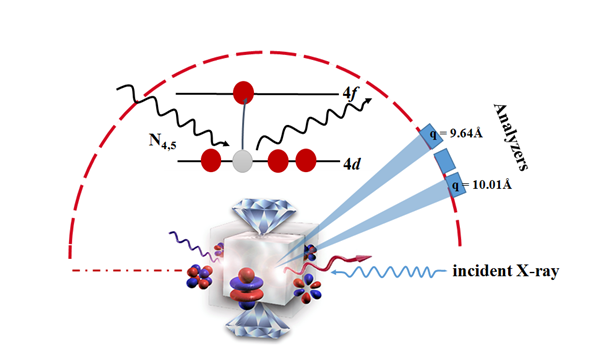Probes the Volume Collapse in Rare-earth Metal with Inelastic X-ray - Drs. Bijuan Chen and Yang Ding
DECEMBER 10, 2019
Understanding the mechanism of volume collapse phenomena in rare-earth materials remains an important challenge in part due to lack of direct information on 4f electronic structures at highpressures. A group of scientists led by Dr. Yang Ding of HPSTAR, reported the first high-pressure inelastic x-ray scattering measurement on elemental cerium (Ce) metal. Their work revealed the critical role of 4f-5d Kondo coupling across the volume collapse, whereas another proposed Hubbard model appears to play a minor role. This study is published in the Journal of Physical Chemistry Letters.
Volume collapse from pressure-induced phase transition is a typical phenomenon in rare-earth materials, but the mechanism on this volume collapse still remains a puzzle in spite of already tremendous studies.
For the first time, the team of scientists set out to apply high-pressure non-resonant inelastic x-ray scattering measurement on a prototype rare-earth metal — cerium, which enabled the team to directly probe the electron changes under compression. “The inelastic x-ray scattering spectroscopic provided very important information on the electronic structural evolution in rare-earth materials across the volume collapse,” said Dr. Ding, a staff scientist of HPSTAR.
Their further calculations show that the spectral redistribution across the volume collapse can be well described by the so-called Kondo model, while the other important theoretical model — Mott-Hubbard transition appears to play a minor role.
“Previous synchrotron spectroscopic experiments on rare-earth metals are mainly related to d obitals. We know quiet few about the electronic structure near the Fermi level,” explained Dr. Bijuan Chen, the lead author of the work. “One major challenge to study the volume collapse phenomena in rare-earth materials is the lack of direct characterizations”. The team is the first enabling a direct measurement on this kind of study, which opens up new opportunities for probing of other pressure-induced interesting phenomena, such as valence transition, and quantum critical fluctuations.” Dr. Yang Ding added.

Caption: The lower-energy-resolution inelastic X-ray scattering (LERIX) spectrometer for measuring the N4,5-edge of Ce at high pressure.
由于缺乏对4f电子结构信息的直接探测手段,导致解释稀土材料中体积坍塌现象的理论模型仍然存在着很大的争议。北京高压科学研究中心的丁阳团队选取代表性的元素铈(Ce)作为研究对象,首次借助高压非弹性x射线散射技术直接研究Ce金属,成功地探测到了Ce的未占据4f态在体积坍塌过程中的变化。该团队进一步将实验与扩展的原子多重态计算进行比较,他们发现4f-5d近藤耦合的微小变化可以很好地描述体积坍缩过程中的光谱重分布,而哈伯德理论模型中相邻原子间的杂化作用似乎不大。这些结果很好的解决了关于铈的体积坍塌机制中的长期争论。该研究首次提供了令人信服的实验证据,有助于约束理论模型,为系统地研究稀土材料的体积坍缩现象开辟了新途径。
